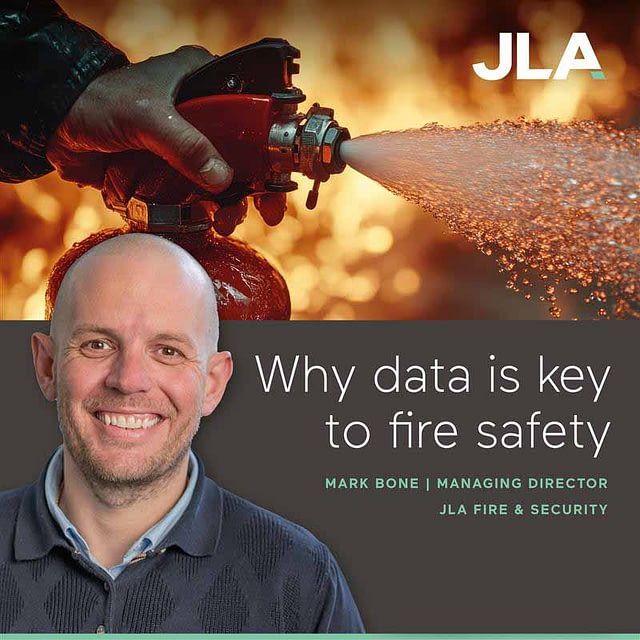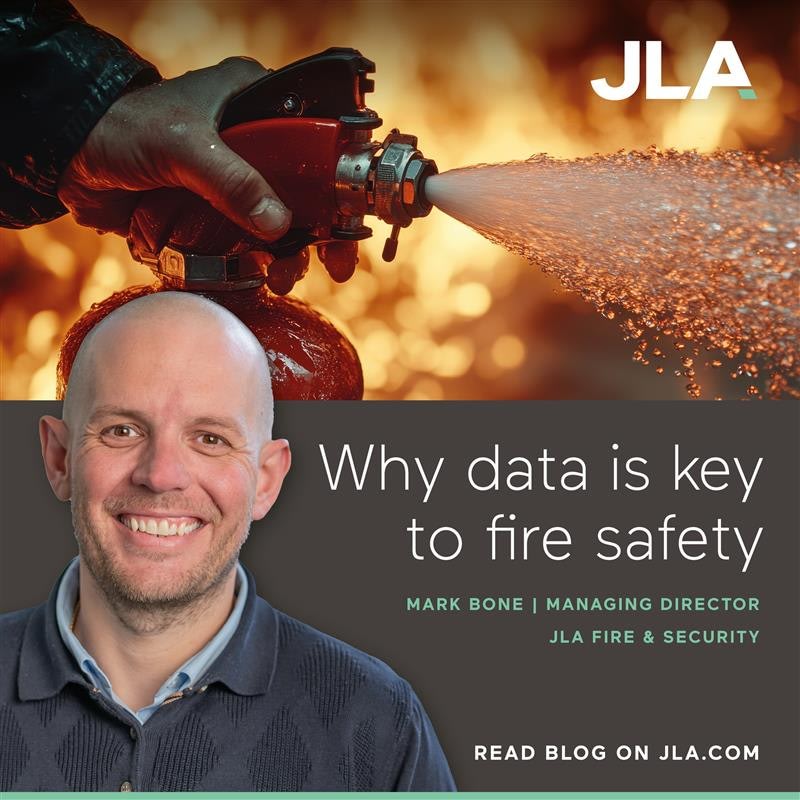In facilities management, conversations about competence often focus on individuals’ skills and capabilities, emphasising professional shortcomings or a lack of knowledge. But fire safety compliance isn’t just about people – it’s also about the assets they look after, and I say this often: not all assets are equal.
When it comes to managing commercial fire safety systems, older or outdated equipment will often come with significant limitations – in terms of data as well as operations – which can lead to issues for facilities managers (FMs) that only multiply when you factor in the management of multiple properties.

Why does asset data matter?
Conventional fire alarms, as one example, are likely to lack diagnostic features, often require time-consuming manual testing, and force FMs to rely almost entirely on planned maintenance or annual system reviews for fault finding and remediation – or respond reactively when a system goes into fault.
Similarly, older sprinkler, fire extinguisher and manually operated systems are unlikely to offer performance data, making it tricky for FMs to spot inefficiencies or failures in real time, while older emergency lighting and fire doors can come with patchy records and inconsistent monitoring.
The constraints of these older systems create blind spots that threaten to impact compliance, are more likely to increase downtime, and make it much harder for organisations to maintain records and evidence their due diligence in the face of tougher fire safety regulations and the public’s desire for demonstrably safer buildings post-Grenfell.
Newer systems, meanwhile, tend to offer features like self- or automatic testing, and will provide ongoing updates about their performance and maintenance needs. Crucially, these updates and insights can usually be accessed remotely, often from one centralised dashboard where swathes of data are continuously available. This means FMs can identify potential issues before they become problems, which helps to mitigate risk, prevent costly downtime, and better support an organisation’s broader compliance obligations.
For FMs striving to maintain compliance, then, the age and complexity of their assets and operational systems will determine competence requirements and generate an extra set of challenges – potentially slowing down analysis and, as a consequence, the pace of any remedial action. The difficulty of information gathering in such environments is also compounded by facilities professionals leaving or changing contractors, with valuable asset histories and building knowledge moving away from the organisation.
So, beyond a costly – and probably unrealistic – investment programme, what can FMs do to mitigate these challenges?
Weaving in the golden thread: adopting best practice from higher risk building management
Far more than a simple box-ticking exercise, record keeping should be viewed as the cornerstone of an organisation’s fire safety compliance strategy – not least because holding detailed information and asset histories will make charting progress and collating evidence for regulators so much simpler.
Implementing a best-practice record-keeping regime doesn’t need to be daunting, though. In fact, the concept of a ‘golden thread of information’ – which is already a legal requirement for Higher Risk Buildings under the Building Safety Act – offers FMs in all sectors a clear and intuitive framework for how building and asset data can be created, maintained, and made accessible, thus improving accountability.
Of course, modern estates increasingly include assets as varied as lifts, solar panels, security, utilities and more, which can make the initial task feel complex. Yet in my experience, applying the principles of the golden thread is transformative for managing assets, easing the burden on FMs who can’t realistically be expected to know everything about the wealth of assets operating across their estate. And while continuous professional development (CPD) and training will remain essential, it’s also far better to be honest about the complexity of compliance, as well as the need for FMs to engage with accredited third-party specialists for support.
Through the golden thread, all of this is made easier. FMs have a way to centralise and protect records and critical knowledge while simplifying compliance for everything from fire doors and extinguishers to emergency lighting and suppression systems. What is more, they can see and act on real-time indicators of performance, asset status, and potential risks, further driving efficiencies and improving sustainability as they go.
Golden thread thinking in action
As one example of how having the correct data to hand can bolster compliance, we can look to the way FMs are beginning to manage the fire risk posed by the growing number of lithium batteries being used across their organisations.
Whether it is phones, laptops, power banks, cameras, or even EVs, lithium batteries are now commonplace. Yet this technology also comes with a set of new safety requirements – a fact that can be overlooked without the right guidance or data to hand.
This is where competence matters: without a properly specified and maintained management system – or the input of experts who understand the associated risks – FMs may simply not know that lithium batteries require separate risk assessments, or that standard extinguishers will not be fit for purpose.
In these situations, then, seeking the support and guidance of a specialist third-party is vital. Their involvement will ensure you have a system that is specified, installed, and maintained to produce reliable data and empower an FM to make informed decisions to stay well ahead of regulatory changes.
By outsourcing challenges like this, FMs can untangle the complex nature of rules and regulations in the current landscape, including scenarios where different priorities are in conflict. One example is the interaction between sustainability and safety, where the drive towards increased use of solar panels, timber construction, and lithium battery-powered personal mobility devices can all impact on the safety of a building and the fire safety systems required.
What is certain, though, is that modern digital tools like apps and cloud-enabled dashboards will continue to clear more paths to compliance, even for the biggest estates. And as outdated systems are replaced, and on-site assets grow ever smarter, FMs will be able to build a more accurate picture of how their organisations are performing in real-time, as well as understanding where risks are emerging, and how compliance is achieved across the board.
The future of FM
The future of compliance is changing quickly. Where once inspection was validated by a sticker telling you that an asset had been tested, the modern CAFM system provides a detailed, tamper-proof data trail which evidences the history of every asset and provides the full compliance picture that organisations increasingly need.
Greater investment in technology will only continue to simplify or automate asset management, data collection, and record keeping, which will help to satisfy regulators and enable facilities professionals to achieve higher levels of competence and efficiency.
Tragedies such as the 2017 Grenfell Tower disaster have underlined the importance of building safety, and specifically fire safety, and with this the obligations of those managing buildings of any kind. Modern facilities teams are more aware than ever of their responsibilities, too, with JLA’s recent research highlighting widespread concern about regulatory compliance in fire safety and HVAC.
Of those surveyed, 20% were very concerned and 60.9% were moderately or slightly concerned, showing a degree of preoccupation with keeping up in a shifting landscape. Interestingly, 15.6% contradicted this trend and responded that they are not worried; I suspect this may reflect confidence in existing compliance processes, smaller estate sizes, or more experienced facilities professionals.
Regardless, compliance is firmly on FMs’ radars, and the consequences of non-compliance are all too real. Under current legislation, responsible persons can face criminal prosecution, severe fines, or even imprisonment. And this is before we consider reputational damage, insurance problems, or, in worst-case scenarios, serious injuries or deaths in the workplace. With all of this in mind, it’s clearly imperative that FMs continue to equip themselves with the tools, safety systems and expertise they need to protect people and assets, and stay ahead.

For more expert insights, visit the JLA Knowledge Hub.



